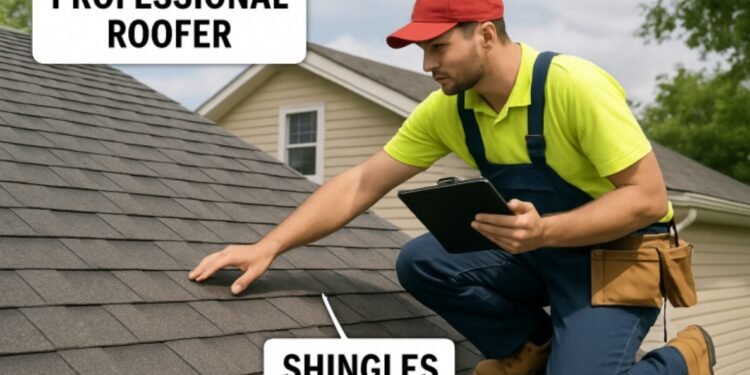Last Updated on November 2, 2025 by admin
Your home is likely your most significant investment, and maintaining its condition requires diligence, particularly regarding your roof. As the barrier between your living space and the elements, the roof constantly faces harsh conditions that can slowly lead to costly repairs or premature replacement. That’s why working with a trusted Roofing Contractor for regular roof inspections is one of the most effective ways to protect your home’s longevity and value.
Regular roof inspections are more than just a routine checkup; they’re an essential preventive measure. Minor issues such as tiny leaks or missing shingles can quickly escalate into major problems if left unattended. Scheduling professional inspections allows you to catch problems early and ensure your home remains protected season after season.
Beyond basic protection, roof inspections can contribute to greater energy efficiency, lower utility bills, and compliance with insurance or warranty requirements. Whether you’re a new homeowner or have lived in your property for years, understanding why regular roof inspections matter and how to choose the right professionals will save you time and money in the long run.
For those searching for comprehensive options, consider partnering with providers offering expert roofing solutions tailored to your needs. Customized services add extra assurance, making sure every corner of your roof is monitored and maintained.
Why Regular Roof Inspections Matter
Your roof acts as the primary defense against the forces of nature—rain, snow, wind, and sun. Over years of exposure, even the most robust roofing systems will experience deterioration. Without periodic assessments, slight imperfections can remain unnoticed until they grow into substantial structural or water damage. Routine inspections ensure these vulnerabilities are found and fixed before threatening your home’s safety and comfort. According to the Family Handyman, routine inspections are among the most vital home maintenance tasks.
Common Issues Identified During Inspections
When professionals conduct roof assessments, they look for a range of issues that could compromise the integrity of your roofing system. Some of the most frequent problems identified during these inspections include:
- Damaged or Missing Shingles: High winds and severe weather can loosen or blow away shingles, exposing the underlayment and leading to leaks.
- Leaks and Water Damage: Small leaks may go unnoticed inside your attic, but if not addressed quickly, they can result in severe structural damage and mold.
- Clogged Gutters: Leaves, twigs, and debris often accumulate in gutters, causing water to back up and potentially seep underneath shingles or cause ice dams.
- Flashing Deterioration: The thin metal strips sealing joints around chimneys, skylights, and vents can corrode or become dislodged, allowing water to penetrate.
Identifying these issues before they worsen helps prevent emergency repairs and protects your home’s interior. The Better Homes & Gardens also highlights the significance of regular checks for these common problems.
Benefits of Regular Roof Inspections
Cost Savings and Preventing Major Damage
Early detection means more minor, lower-cost fixes than expensive repairs or roof replacements. For example, a basic inspection fee is a small price compared to the thousands you might pay in the event of significant structural damage or indoor flooding.
Extended Roof Life
Homeowners who prioritize routine inspections and scheduled maintenance may add 10–15 years to their roof’s average lifespan. This delay in replacement benefits both their budget and their peace of mind.
Energy Efficiency
A roof in good repair helps maintain consistent indoor temperatures. Proper insulation and intact shingles mean your HVAC won’t work overtime, lowering energy use and utility bills as recommended by the U.S. Department of Energy’s guidelines on home weatherization.
Insurance and Warranty Compliance
Regular reports from professional inspections are often required to keep your insurance active or to ensure any manufacturer’s warranties remain valid. If damage is left unchecked, you risk denied claims or voided warranties.
Recommended Frequency for Roof Inspections
The National Roofing Contractors Association advises homeowners to schedule at least two roof inspections annually—once in the spring and again in the fall. These regular checkups catch damage from severe winter weather or summer heat before it develops into costly repairs, helping keep your home safe year-round.
Choosing a Professional Roof Inspector
Selecting a qualified inspector is critical to thorough, reliable roof assessments. Homeowners should:
- Verify Credentials and Experience: Look for inspectors with appropriate licensing, insurance, and proven experience working with your roof type.
- Check References and Online Reviews: Positive testimonials and word of mouth offer peace of mind and accountability.
- Request Comprehensive Services: A professional should offer detailed reports, photographs, and clear recommendations for repairs.
Conclusion
Scheduling regular roof inspections with knowledgeable professionals offers significant protection and value for your home. Inspectors catch minor issues before they escalate and extend your roof’s life, support lower energy costs, and ensure you’re covered by insurance and warranties. Bi-annual inspections are a simple yet highly effective way to keep your home and investment secure for years.
Key Takeaways
- Regular roof inspections help detect minor issues before they escalate into major problems.
- Inspections can extend the lifespan of your roof and improve energy efficiency.
- Professional assessments ensure compliance with insurance and warranty requirements.









